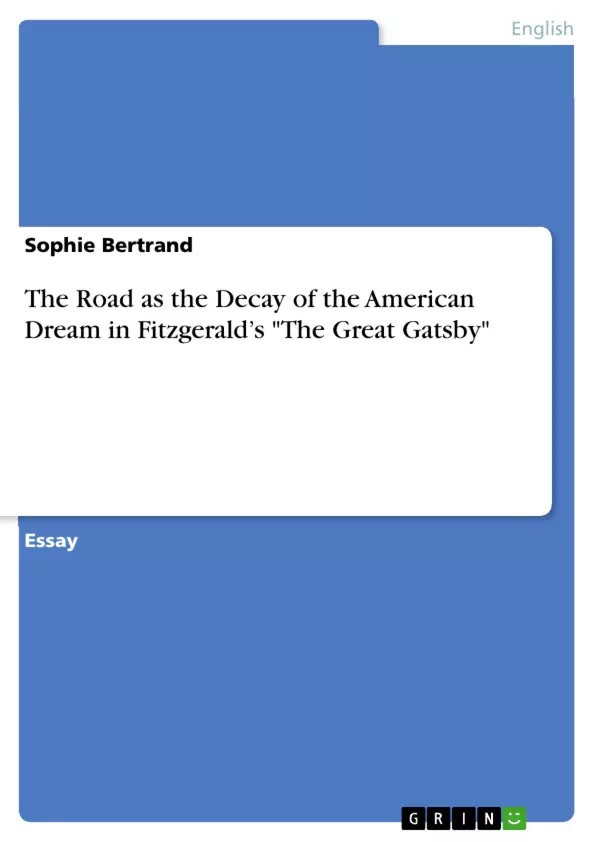Francis Scott Fitzgerald’s The Great Gatsby was published in New York in 1925. Those years in America, the 1920s, are often considered as the Roaring Twenties: a decade of great social change, a decade of jazz, an age of success and American Dream, an age of everything. The American Dream is often described as the aspiration of young Americans to live better than their parents: without war, poverty and misfortune but with love, wealth and happiness. In fact after World War I many Americans wished to return to the peaceful time they had before the war. During the 1920s, Americans focused on building economic prosperity and most people focused on the present with little concern for the future: life became easier and more enjoyable. Unfortunately, this age of prosperity, complete independence, self-reliance and opportunity quickly became an age of downfall: in order to pursue this utopia, people were asked to work harder. In consequence they could not prosper themselves but only endured.
Fitzgerald condemns this American society of the 1920s that has lost its pursuit of progress for happiness to finally become purely materialistic and corrupt.
In this essay, I will deal with the road from the Midwest to New York City and the road from West Egg to East Egg both exemplifying the decay of the American Dream, personified by the characters of Jay Gatsby and Nick Carraway, as there is a strong relationship in the novel between the geography of the roads and the characters’ social values. On the one hand is the journey of Nick Carraway coming from the Midwest and going to New York City where he discovers corruption and immorality. On the other hand we find the road Jay Gatsby is following to be accepted among the wealthiest and to be loved by Daisy. This road, from West Egg to East Egg, represents the movement from solemnity and honesty to obsession of class and privilege.
I wish to show that these two roads epitomize the decay of the American Dream: through two main characters of the novel and in two different ways that we will discover in this essay, the two roads or journeys that are followed by these two characters start from a point of moral prosperity to move them towards a state of moral decay: Gatsby more profoundly than the Nick. This essay will be twofold: the first part will concern the road from West Egg to East Egg that Jay Gatsby follows while the second part will deal with the road of Nick Carraway: the road from the Midwest to New York City.
Table of Contents
- Jay Gatsby's road: from West Egg to East Egg
- Nick Carraway's road: from Midwest to New York City
Objectives and Key Themes
This essay analyzes the journey from the Midwest to New York City and the journey from West Egg to East Egg in F. Scott Fitzgerald's The Great Gatsby, examining how these journeys embody the decay of the American Dream. The essay focuses on the characters of Jay Gatsby and Nick Carraway, who represent different aspects of this decay.
- The corrupt nature of the American Dream in the 1920s
- The contrast between the "new rich" of West Egg and the old aristocracy of East Egg
- The role of materialism and social status in the pursuit of happiness
- The consequences of obsession and illusion in achieving the American Dream
- The loss of morality and spiritual values in a materialistic society
Chapter Summaries
The first part of the essay will focus on the road from West Egg to East Egg, examining Jay Gatsby's journey and his pursuit of Daisy. Gatsby's luxurious lifestyle in West Egg, though seemingly prosperous, reflects the hollowness and superficiality of the American Dream. Despite his wealth, Gatsby's obsession with Daisy leads him to moral decay. The chapter will analyze the contrast between West Egg's newly rich and East Egg's old aristocracy, highlighting the common theme of moral irresponsibility in both.
Keywords
The key terms and concepts explored in this essay include the American Dream, social class, materialism, corruption, moral decay, illusion vs. reality, obsession, and the 1920s. The essay focuses on the consequences of pursuing a materialistic and superficial version of the American Dream.
- Quote paper
- Sophie Bertrand (Author), 2011, The Road as the Decay of the American Dream in Fitzgerald’s "The Great Gatsby", Munich, GRIN Verlag, https://www.grin.com/document/188231



